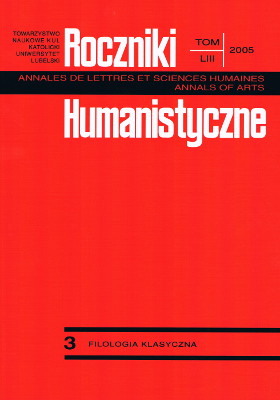Tibullus – “amicus Sulpiciae”? Hypothetical Considerations
Abstract
Horacy seems to be the literary authority for Tibullus, and his cantos, especially I, 33 and III 12, might have suggested him the idea of showing the emotional relations between various subjects and protagonists. As a poeta doctus, observing the axioms of alexandrine poetics, he tackles the subjects (e.g. homosexual), interests (e.g. rustic), and especially composition rules (e.g. variatio) that were present in it. Despite his own biography he plays the role of a poor lover, alien to all military actions. He stresses his status of a poet that connects him to Lygdamus and Sulpicia, his literary creations, independent of their real models. Both Lygdamus and Sulpicia speak according to the elegiac convention, and the concurrence of motifs, imaging, and the style of Book III and the previous Books may be considered self-paraphrases. Also Panaegyricus Messalae may be an exceptional and marginal attempt to write something in a different genre, although one that would have compositional roots in the whole of Book III, with its construction analogous to the two previous ones, and also signed with the poet’s name. It is not different authors, but impersonating different egos and quoting utterances stylized in various ways that materialize the principle of variatio. For readers who always expect the author and the egos in his poetry to have the same biography the idea has proven too difficult even today. Hence multiplying the authors and the constant identifying of their biographies.
References
Abramowska J.: A jednak autor, [w:] Ja, autor. Sytuacja podmiotu w polskiej literaturze współczesnej, red. D. Śnieżka, Warszawa 1996, s. 58-63.
Albrecht M. von: Ovide imitateur de Tibulle, „Les études classiques” 51 (1983), s. 117-124.
Baligan G.: Il terzo libro del Corpus Tibullianum, [w:] Studi publicati dall’Istituto di Filologia Classica, Bologna 1948, s. 1-36
Boucher J. P.: A propos de Cerinthus (C.T. III, 9-18) et quelques autres pseudonymes dans la poésie augustéenne, „Latomus” 35 (1976), s. 504-519.
Boucher J. P.: Die Elegien des Lygdamus, „Hermes” 93 (1965), s. 65-112.
Cairns F.: Propertius I, 18 and Callimachus, Acontius and Cydippe, „Classical Review” 20 (1969), s. 131-134.
Cairns F.: Tibullus. A Hellenistic Poet at Rome, Cambridge 1979.
Cartault A.: Tibulle et les auteurs du Corpus Tibullianum. Texte établi par …, Paris 1909.
Crillo O.: Spunti di poetica tibulliana. Tra idilla ed epigramma alessandrino, „Bolletino di studi latini” 29 (1999), s. 44-62.
Currie H. MacLeod: The Poems of Sulpicia, [w:] Aufstieg und Niedergang der römischen Welt, II, 30, 3, Berlin 1983, s. 1751-1764.
Cytowska M., Szelest H.: Literatura rzymska. Okres augustowski, Warszawa 1990.
Danielewicz J.: Relacja: autor-pomiot literacki w liryce greckiej, [w:] Autor. Podmiot literacki. Bohater. Studia pod red. A. Martuszewskiej i J. Sławińskiego, Wrocław 1983, s. 129-142.
Foulon A.: Les laudes ruris de Tibulle II, 1, 27-80. Une influence possible de Lucrèce sur Tibulle, „Revue des études latines” 65 (1987), s.173-188.
Foulon A.: Tubulle II, 5: hellenisme et romanité, „Revue des études latines” 61 (1983), s. 173-188.
Fredricks S. C.: A Poetic Experiment in the Garland of Sulpicia (C. Tib. III, 10), „Latomus” 35 (1976), s. 761-782.
Gärtner T.: Die Destruktion des elegischen Wertgefüges. Zu den beiden Elegienbüchern des Albius Tibullus, „Eos” 90 (2003), fasc. 2, s. 215-245.
Govaerts S.: Le Corpus Tibullianum. Index verborum et relevés statistiques: Essai de methodologie statistique, Université de Liège, La Haye 1996.
Iwasiów I.: Autoparafraza jako sygnatura, [w:] Ja, autor. Sytuacja podmiotu w polskiej literaturze współczesnej, red. D. Śnieżka, Warszawa 1996, s. 163-175.
Lenz L.: Tibull in den Tristien, „Gymnasium” 104 (1997), s. 301-317.
Luck G.: The Latin Love Elegy, London 1969.
Stoff A.: Ja, autor. O funkcjach sygnatur w literaturze, [w:] Ja, autor. Sytuacja podmiotu w polskiej literaturze współczesnej, red. D. Śnieżka, Warszawa 1996, s. 64-78.
Swoboda M.: Albius Tibullus poeta elegijny, Poznań 1969.
Swoboda M.: Autorzy trzeciej księgi tzw. Corpus Tibullianum, „Eos” 58 (1969/1970), fasc. 1, s. 99-114.
Swoboda M.: De Panegyrico Messalae in Corpore Tibulliano asservato, „Symbolae Philologorum Posnaniensium” 1 (1973), s. 115-132.
Wifstrand-Schiebe M.: Das ideale Dasein bei Tibull und die Goldzeitkonzeption Vergils, Uppsala 1981.
Witczak K. T.: Horacy a Lygdamus. Nowe spojrzenie na początki elegii rzymskiej, „Meander” 68 (1993), s. 135-143.
Witczak K. T.: Rzymski elegik Serwiusz Sulpicjusz – znany czy nieznany?, [w:] In honorem memoriamque Stephani Oświęcimski, Łódź 1995, s. 113 -118.
Witczak K. T.: Tzw. „Wieniec Sulpicji” i jego autorzy – Sulpicja i jej brat Serwiusz Sulpicjusz, „Meander” 68 (1993), s. 37-48.
Wójcik A.: Tibullusa wiersz okolicznościowy na cześć Messali (Tib. I, 7), „Symbolae Philologorum Posnaniensium” 8 (1991), s. 77-89.
Zarzycka-Stańczak K.: Pieśni miłosne Horacego, „Roczniki Humanistyczne” 17 (1969), z. 3, s. 69-94.
Zarzycka-Stańczak K.: Z badań nad pierwszym zbiorem Pieśni Horacego, Wrocław 1969.
Ziomek J.: Autobiografizm jako hipoteza konieczna. (Treny Jana Kochanowskiego), [w:] tenże, Powinowactwa literatury, Warszawa 1980, s. 215-243.
Copyright (c) 2005 Roczniki Humanistyczne

This work is licensed under a Creative Commons Attribution-NonCommercial-NoDerivatives 4.0 International License.





